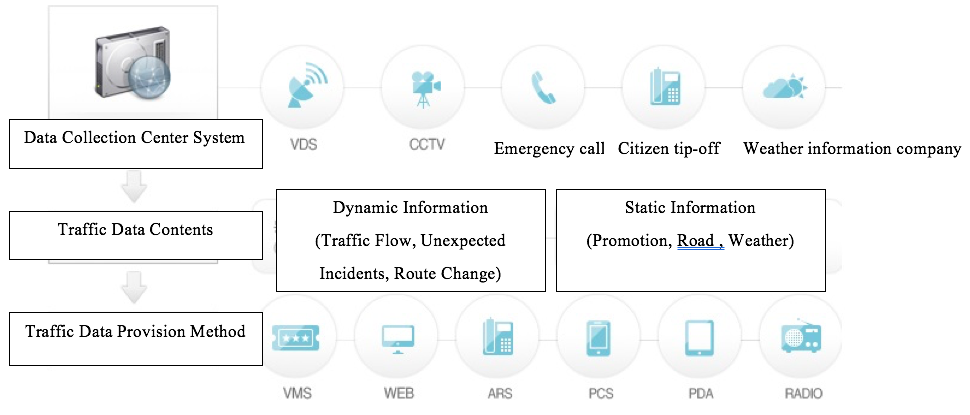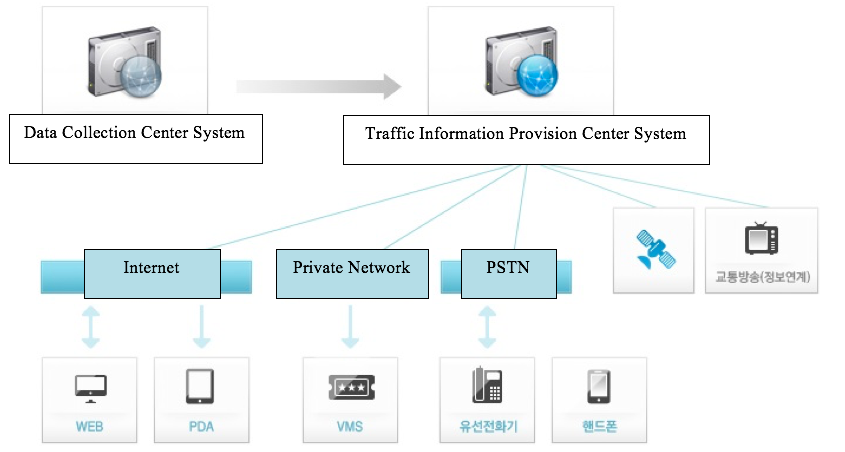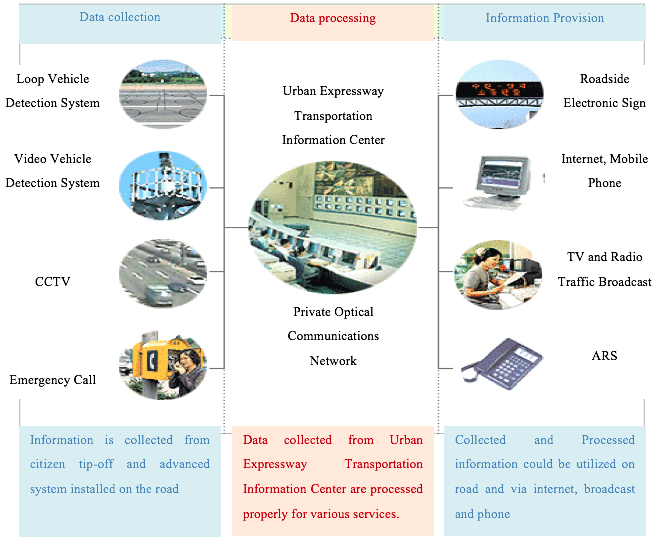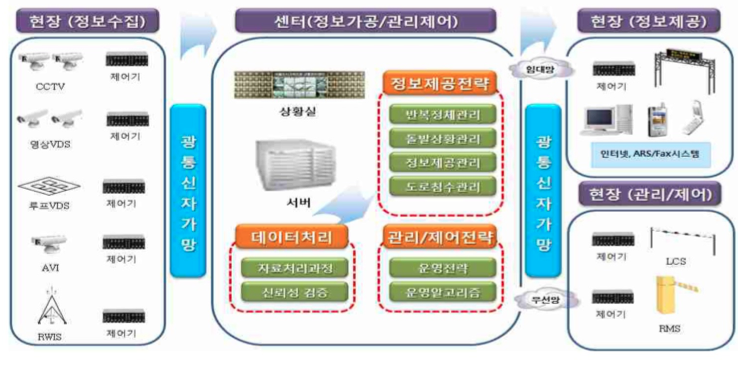Seoul’s Intelligent Traffic System (ITS)
Policy Implementation Period
Table 1. Seoul’s Urban Expressway FTMS Projects in Phases
| Segment | Start | Completion | Segment Length | |
| Initiation | Olympic Expressway | July 1997 | February 1998 | 18km |
| Phase 1 | Naebu Inner Beltway | May 2000 | June 2002 | 40.1km |
| Phase 2 | Gangbyeon Riverside Expressway/Bukbu Northern Arterial Road | November 2001 | June 2004 | 21.7km |
| Olympic Expressway/ Nodeul Road & Han River Bridge |
October 2003 | September 2005 | 49.3km | |
| Phase 3 | Dongbu Eastern Arterial Road/Gyeongbu Expressway | April 2005 | April 2007 | 45.7km |
| Phase 5 | Gangnam Beltway | May 2015 | May 2016 | 12.4km |
| Total | 187.2km |
Background Information
The rapid development of the Korean economy and the automobile industry in the 1980s brought about a sharp rise in traffic volume. The number of passenger cars exceeded one million in 1990, and rose to over two million units by 1995 with more than half of them being used in Seoul. Thus, in less than five years, the number of cars owned by Seoul citizens almost doubled to two million. Such a surge in car ownership quickly led to snowballing social costs - including road congestion and traffic accidents - in the City of Seoul.
The decision-makers of the city’s transportation policy during that period shared the view that the existing supply-oriented approach - which was largely focused on expanding facilities, including continuous expansion of the transportation system and construction of new roads - might no longer be viable and started seeking a new approach in a bid to break away from conventional transportation policies. At that time, other countries were expressing a keen interest in the intelligent transportation system (ITS), which applied cutting-edge technology to transportation facilities. The ITS was an innovative approach that was very appealing to policy makers as it helped promote the efficient management of existing traffic facilities by promoting efficient traffic flow at much more affordable costs compared with the provision of infrastructure facilities, including the construction of new roads. For that reason, an increasing number of cities in other countries showed interest in adopting the ITS, and South Korea pursued various ITS research and development programs and pilot projects in the 1990s. In line with such a move, the City of Seoul also promoted the adoption of an advanced overseas ITS. In the initial period, Seoul began promoting the urban expressway FTMS on a large scale. In fact, the urban expressway FTMS ultimately became one of Seoul’s most representative ITS projects, dramatically improving the efficiency of its urban expressways.
Article 77 (Implementation of the Project to Establish Intelligent Transport Systems) of the National Transport System Efficiency Act provides the legal grounds for projects aimed at establishing the urban expressway traffic control system.
The Importance of the Policy
The implementation of the FTMS on Seoul Urban Expressways started in the mid-1990s when the Intelligent Transportation System (ITS) was gaining much attention, leading to Seoul’s introduction of the ITS in earnest.
The Intelligent Transportation System (ITS) is an advanced traffic management system that enhances the efficiency and stability of transportation, conducts scientific and automatic operation and management of the transportation system, and provides traffic information and services through the use of cutting-edge technology - including electronic technology, control technology and communications technology - to the means of transportation, transportation facilities and infrastructure.
The implementation of the FTMS enabled real-time traffic control and automatic information/data collection of the urban expressways, thus enabling a prompt response to adverse traffic conditions and emergencies and improving the efficiency of the traffic system, which had previously been manually operated.
Relevance with other Policies
Seoul’s FTMS Project in 4 Phases
Phase 4 was designed to improve the major bypasses of the urban expressways, and the FTMS was installed along 82.5 km of expressway between August 2011 and August 2013.
During the first to third phases of the FTMS project, as mentioned earlier, the FTMS was successively implemented along the Olympic Expressway, Naebu Inner Beltway, Gangbyeon Riverside Expressway/Bukbu Northern Arterial Road, Nodeul Road & Han River Bridge, Dongbu Eastern Arterial Road, and Gyeongbu Expressway (managed by the City of Seoul). In the 4th phase, the advanced management system FTMS, was installed on major arterial roads of the urban expressways with the aim of dispersing the traffic volume and enabling the optimal dispersion of traffic based on the real-time FTMS implemented on major bypasses. The FTMS was installed on the following arterial roads:
- 1st group: Banpo-ro, Hannam-ro, Gangnam-daero, Heolleung-ro, Dongjak-daero, Doomoogae Road, etc. (42km)
- 2nd group: Hwarang-ro, Jeongneung-ro, Segeomjeong-gil, Jinheung-ro, Tongil-ro, etc. (23km)
- 3rd group: Dongil-ro (18km)
FTMS System Advancement
FTMS on Expressway
The FTMS was not only installed on urban expressways in Seoul but was also planned to be installed on expressways across the nation under the management of the Korea Expressway Corporation. Due to the widespread implementation of the FTMS on expressways throughout the country, the Intelligent Transportation System (ITS) is the best - or even the most perfectly - realized system on expressways among all the road types in Korea.
In order to allow for the efficient management of the expressways based on ‘intelligent’ expressways across the nation, the KEC has deployed and now operates a high-speed optical communications network covering the country’s 24 expressway routes, totaling 2,646km, including the Gyeongbu Expressway, since 1993.
The communications network provides on-site IT infrastructure for the KEC’s work and also serves as a field communications network for the FTMS, toll collection system (TCS), hi-pass system (toll payment system), and emergency calls.
Policy Objectives and Processes
The FTMS aims to enhance the efficiency of expressways. More specific policy goals can be summarized as follows:
➀ To check the transportation and road situation on urban expressways, identify the causes of congestion and how to improve them, and ultimately promote efficiency in the traffic management system.
➁ To guarantee the mobility of urban expressways (maintaining a travel speed of 40km/h or higher).
➂ To guarantee public safety on urban expressways (zero traffic fatalities).
➃ To reduce travel costs by removing the causes of irregular traffic congestion based on the automatic detection of unexpected incidents and prompt responsive measures.
➄ To establish a convenient and pleasant traffic environment by offering traffic information to road users.
Main Policy Contents
The Freeway Traffic Management System, or FTMS for short, and the Seoul Urban Freeway Traffic Management System are the intelligent transportation systems (ITS) installed on expressways by the SMG to centrally manage the traffic situation and to provide detailed traffic information to drivers on the expressways in real time.
The ITS efficiently manages the traffic flow with its combination of “hardware” (roads, construction, transportation, communications, electricity, electronics, automobiles, etc.) and “software” (operating methods, information processing techniques, etc.) technologies, thus dispensing with the need for a large workforce. The main goals of deploying the ITS are to provide the optimal route for individual passengers, to induce convenient and safe passage, to detect the causes of delays including unexpected incidents and provide solutions to them and, ultimately, to maximize the efficiency of the overall transportation system.
As such, the main function of the FTMS is to collect information on traffic conditions and to process and use the collected data. Information is gathered using a loop vehicle detector, which is installed under the road and detects the traffic flow, and a video vehicle detector, which identifies the traffic flow based on video recording, as well as CCTVs and emergency phone calls. In addition, tip-offs from road users provide a good source of information. Figure 1 is a schematic representation of the devices and information media used to collect and process data and to provide information.
Transportation Data Collection System
The Transportation Data Collection System collects information on the traffic flow, weather changes, and unexpected incidents that happen on expressways using VMS, CCTVs and emergency call technologies.

Traffic Information Provision Center System
The Traffic Information Provision Center System promptly provides information on expressway conditions to drivers and users by processing collected traffic information via VMS, LCS, ARS, emergency broadcast system, and WEB technologies among others.

Figure 1. FTMS Data Collection Processing Provision

Source: Seoul Metropolitan Government (2013)
As of 2013, a total of 1,193 traffic data collection devices had been installed on the urban expressways in Seoul, including 1,047 Vehicle Detection Systems (VDS), 144 CCTVs, and two Road Weather Information Systems (RWIS). Among the media providing traffic information were 260 Variable Message Signs (VMS) as well as the website of the Seoul Urban Expressway Traffic Control Center, ARS and fax. On top of these, traffic flow control devices have been installed, including 30 Ramp Metering Systems (RMS), 33 Lane Control Systems (LCS), and cutting-in controllers.
Table 2 below shows the number of on-site data collection devices constituting Seoul’s urban expressway FTMS that were in operation at each phase of the FTMS project. The collected data are directed to the Urban Expressway Traffic Control Center where all traffic information is to be collected. The center provides the collected data directly to the users or transmits it to other relevant institutions. It also receives information from other institutions and provides it to users via diverse media, as summarized in Table 3.
Table 2. Installation of the FTMS on Seoul Urban Expressways
|
Data Collection Devices |
Data Provision and Control Devices |
|||||||||
|
Category |
VDS |
CCTV |
RWIS |
VMS |
RMS |
LCS |
cutting |
Internet |
Others |
|
|
Video |
Loop |
|||||||||
|
Phase 1 |
213 |
24 |
38 |
- |
62 |
12 |
- |
- |
web page |
ARS/ |
|
Phase 2 |
120 |
2 |
22 |
- |
43 |
- |
- |
- |
||
|
218 |
124 |
40 |
2 |
81 |
- |
19 |
- |
|||
|
Phase 3 |
194 |
10 |
36 |
- |
61 |
19 |
14 |
2 |
||
|
Phase 5 |
|
|||||||||
Source: Seoul Metropolitan Government (2013, 2014)
* Acronym
VDS: Vehicle Detection System
RWIS: Road Weather Information System
VMS: Variable Message Sign
CCTV: Closed-Circuit Television
RMS: Ramp Metering System
LCS: Lane Control System
As of April 2007, the Seoul Metropolitan Government had installed the FTMS in nine segments (180.4km in total) of the urban expressways based on a high-speed communications network. Meanwhile, as of 2013, a total of 1,041 vehicle detection systems (VDS), 144 CCTVs and 260 roadside electronic signs had been installed across Seoul’s urban expressways for the collection and provision of traffic data.
The Seoul Urban Expressway Traffic Information Center serves as the information source of the Korea Expressway Corporation, providing effective and proactive traffic management 24/7 and accurate real-time traffic information. The information center provides prompt traffic management in the event of unexpected emergencies, including traffic accidents and disasters on the expressways, and helps ensure a smooth traffic flow via the swift provision of traffic data after collecting and analyzing real-time traffic data. In particular, it helps drivers find the optimal routes by offering integrated transport information, including national highway and urban roads, as well as expressway information. Integrated traffic data are also provided in real time to various broadcasting media including TV and radio stations, DMB, and mobile phones, PDAs, navigation devices, ARS and the Internet. Drivers on the expressways can also assess the traffic information for themselves by reading the roadside electronic signs.
Table 3. External Information Links to the FTMS
| Category | Details of Information | Frequency | Use of Information | |
| From | Seoul Metropolitan Police Agency | Traffic flow at a fixed point (at 1 min intervals), traffic flow at a fixed segment (at 1 min intervals), unexpected incidents | 1 min | - |
| CCTV feed | - | - | ||
| Korea Expressway Corporation | Traffic flow at a fixed segment (at 1 min intervals) | 5 min | - | |
| Traffic Broadcasting Station (TBS) | CCTV feed | - | - | |
| Seoul Transport Operation & Information Service (TOPIS) |
Traffic flow at a fixed segment (at 1 min intervals) | 5 min | - | |
| CCTV feed | - | - | ||
| Expressway to Incheon International Airport | Traffic flow at a fixed segment (at 1 min intervals), unexpected incidents | 5 min | - | |
| To | Expressway to Incheon International Airport | Traffic flow on the Incheon Airport Expressway (Bukno JC – Airport) | 10 min | Provision of traffic information online |
| Traffic flow on the Gyeongbu Expressway (Hannam – Shingal), Oegwak Outer Beltway (Toegyewon – Ilsan) |
5 min | Provision of traffic information online, for display on operation devices and online maps | ||
| Seoul Metropolitan Fire & Disaster Headquarters (Seoul Emergency Operations Center) |
Weather data | 1 min | Provision of weather information online | |
| Data on dams, Han River water level, and precipitation | - | Operation devices | ||
| Namsan Zone Traffic Data |
Traffic flow at a fixed segment (at 1 min intervals) |
1 min | Provision of traffic information on the Namsan Zone via VMS | |
Source: Seoul Metropolitan Government (2013)
Technical Details
The FTMS is composed of a field system, which collects and provides traffic information, and a center system, which manages the process and analysis of traffic data, and system operation and integration of external links to the FTMS. As shown in Figure 3, information on weather and transportation collected by the vehicle detection system, CCTVs (closed-circuit television), and Road Weather Information Systems are processed and analyzed by the information processing system, a part of the center system, and provided to users via the ARS and the Internet, and are even displayed on variable message signs (VMS). Also, the FTMS exchanges information with organizations such as the Korea Expressway Corporation, the Seoul Metropolitan Agency, and the Seoul Emergency Operations Center, all of which are linked via the information network. Figure 2 is a schematic diagram of the elements of the urban FTMS and their relationship.
Figure 2. The Structure of the Urban Expressway Traffic Management System

Source: Seoul Metropolitan Government (2016)
Policy Effects
Social Benefits
| Category (Year/ Benefits) |
Reduced Travel Time in Mainline | Route Change (Bypass) |
Reduced Time In Responding to Unexpected Incidents | Reduced Energy Consumption (Operational Costs) | Improved Environment (Air Quality) |
Sum |
| 2003 | 16,634 | 472 | 3,910 | 5,647 | 565 | 27,229 |
| 2004 | 16,673 | 532 | 4,906 | 5,709 | 597 | 28,418 |
| 2005 | 25,181 | 765 | 6,201 | 9,579 | 963 | 42,689 |
| 2006 | 45,319 | 4,935 | 7,739 | 10,769 | 1,053 | 69,815 |
| 2007 | 72,382 | 7,793 | 10,942 | 6,679 | 649 | 98,445 |
| Total | 176,189 | 14,497 | 33,697 | 38,383 | 3,829 | 266,595 |
| Percentage (%) | 66.1 | 5.4 | 12.6 | 14.5 | 1.4 | 100.0 |
Table 5. The Criteria for Determining the Effectiveness of Each Benefit Item
| Category | Benefit Items |
| Direct Benefits |
Lower Vehicle Operation Costs Faster Travel Times (Mainline, Bypass) Faster Response to Unexpected Incidents (Traffic Accidents, Breakdowns, etc.) Fewer Traffic Accidents Enhanced Pleasantness, Punctuality and Safety of Travel |
| Indirect Benefits |
Lower Environmental Costs Regional Development Effect due to Improved Transportation System Expansion of Market Area |
The Price the User Is Willing to Pay
User satisfaction with information provision was computed by quantifying the qualitative evaluation items based on a survey on ‘the price the user is willing to pay’ to the FTMS information provision media (excluding Variable Message Signs). The qualitative benefits were calculated by multiplying the average price that the ‘user is willing to pay’ to each information-providing medium by the number of the user’s annual uses of each medium. As shown in Table 6, the type of Internet traffic information that was used far more frequently than other media turned out to have generated the biggest benefits.
Table 6. The Price Each User Is Willing to Pay for Data from the Urban Expressway FTMS, Annual Usage and Benefits
|
Category |
Internet |
ARS |
SMS |
FAX |
Cell Phone |
PDA |
|
The price that the user is willing to pay (KRW/case) |
55 |
38 |
38 |
24 |
57 |
|
|
Category |
Internet |
ARS |
SMS |
FAX |
Cell Phone |
PDA |
|
Usage |
3,932,823 |
320,999 |
170 |
625 |
16,742 |
4,764 |
|
Benefits |
216,305 |
12,198 |
6 |
15 |
954 |
272 |
Source: Ministry of Land, Transport and Maritime Affairs 2009
The use of variable message signs (VMS) was not included in the target of the abovementioned survey as their usage is not optional. Instead, reliability was checked in the survey, and the users generally appeared to find the information on the VMSs reliable. For each type of information, users found the information on traffic delays and congested areas on expressways (3.64 out of 5 points) the most reliable, followed by information on unexpected incidents and situations (3.54 points) (SMG 2007).
A more recent survey from 2013 showed that drivers used FTMS information 11.7 million times, indicating a sharp rise from the 4.6 million times recorded in 2007. While the use of FTMS information via the Internet remains high, the number of searches of information using mobile phones was about 5.8 million in 2013 due to a surge in the use of mobile devices including smart phones. Table 7 below indicates the annual use of Seoul’s FTMS transportation data by each medium.
Table 7. Use of Seoul’s FTMS Transportation Data by Each Medium (Unit: No. of cases/Year)
|
Category |
2003 |
2004 |
2005 |
2006 |
2007 |
2008 |
2009 |
2010 |
2011 |
2012 |
2013 |
|
Total no. of usages |
2,256,940 |
2,780,286 |
3,026,974 |
4,276,123 |
4,593,626 |
4,862,232 |
5,930,403 |
10,449,609 |
18,117,411 |
13,612,320 |
11,777,260 |
|
Internet |
2,025,411 |
2,584,203 |
2,822,365 |
3,932,823 |
4,059,065 |
4,294,350 |
5,337,458 |
9,904,212 |
17,759,764 |
13,364,052 |
5,726,604 |
|
Mobile |
Uncounted |
5,811,771 |
|||||||||
|
ARS/FAX |
222,342 |
185,664 |
192,151 |
321,624 |
501,039 |
528,204 |
545,110 |
491,263 |
316,693 |
178,101 |
122,922 |
|
Telephone |
9,187 |
10,419 |
12,458 |
16,742 |
16,493 |
14,335 |
12,955 |
10,077 |
7,709 |
6,226 |
4,972 |
|
Feature Phone, PDA |
- |
- |
518 |
4,934 |
17,029 |
25,343 |
34,880 |
44,057 |
25,155 |
54,753 |
7,794 |
|
|
- |
- |
- |
- |
- |
- |
- |
- |
8,090 |
9,188 |
|
Source: Seoul Metropolitan Government (2013)
Challenges and Solutions
The Seoul Metropolitan Government’s experience in deploying and operating the FTMS over the past twenty years is, by and large, very positive but there remains some room for improvements in the following three aspects.
➀ Performance of applied technology
➁ Securing of the budget required to replace the deteriorated transportation management system
➂ Linkage of the ITS with arterial roads
Performance of Applied Technology
The performance of devices and facilities that collect traffic information needs to be supplemented. The Traffic Information Bureau of the Seoul Metropolitan Facilities Management Corporation has established a master plan for the ITS performance evaluation of the FTMS, and has laid the foundation for testing the accuracy of traffic volume/speed measurement of each detector through the complete enumeration of the vehicle detection system, video frame analysis, relative inspection of the traffic volume and reconfiguration (recalibration or change setting) of video-based vehicle detectors (Seoul Metropolitan Facilities Management Corporation, 2014). Along with a performance test, thorough management of measures applied to facilities that fail to meet the standard will be necessary.
Also, with regard to certain sections of the FTMS, it has been pointed out that the ‘simultaneous’ or ‘real-time’ provision of information has some limitations, i.e. it takes a long period of time or frequency of updates is long for the commercial data to be utilized or for the information to appear on the electronic map of the traffic information center after collecting vehicle data from the vehicle detection system on the road. Therefore, greater efforts are needed to provide information in real time by shortening the update frequency and by reducing the time required for data processing based on a higher, more dispersed server load.
Securing of the Budget Required to Replace Deteriorated Facilities
FTMS Advancement Plan
Under Phase 4 of the FTMS project (2011-2013), the FTMS was deployed on arterial roads and the main bypasses of urban expressways, with the goal of optimally dispersing the traffic volume to bypasses from the urban expressways.
-To extend entrance/exit control to urban expressways by implementing integrated control and linkage with arterial roads in response to real-time traffic situations.
-To provide a risk alert service that warns users of risks to safe driving, including hazardous sections on expressways.
Table 8. FTMS System Advancement Plan by Year
| Progress/Year | FTMS System Advancement |
| 2013 | Improvement of design and system |
| 2014 | |
| 2015 | Deployment of FTMS system and development of control strategy (Installation of field system on 96.7 km of road each year) - Development of control strategy and installation of system on mainline and ramp segments - Establishment of the ITS with the focus on hazardous segments |
| 2016 | |
| 2017 | |
| 2018 | |
| 2019 | Implementation of integrated linkage and control between urban expressways and arterial roads Widespread installation and advancement of the Intelligent Safety System using communications technology between cars. |
| 2020 | |
| 2021 |
Source: SMG, Urban Transportation Master Plan, 2014
The management of traffic flow is expected to become more efficient if 1) performance testing and replacement of deteriorated facilities are effectively performed, 2) the FTMS system advancement project is conducted according to the plan, and 3) FTMS information is effectively exchanged with information collected and provided by the private sector.
References
- Lee Sangtaek, 2007, www.gyotongn.com “Seoul Urban Expressway Goes Smart”
- Ministry of Land, Infrastructure and Transport, 2015, 2015 Intelligent Transportation System (ITS) Implementation Plan
- Ministry of Land, Transport and Maritime Affairs, 2009, Study on Effect Analysis and Evaluation method of the ITS project, Final Report from The Korea Transport Institute
- Seoul Metropolitan Facilities Management Corporation, 2014, Seoul Master Plan for the Performance Evaluation of FTMS and ITS.
- Seoul Metropolitan Facilities Management Corporation, 2004, “Seoul FTMS White Paper.”
- Lee Gyeong-sun, Kim Jae-woo, 2006, “Seoul FTMS Operation & Future Development”, Transportation Technology & Policy, Volume 3, Issue 2.
- Seoul Metropolitan Government, 2007, “Analysis & Assessment of FTMS Effectiveness”
- The Korea Transport Institute, 2007, “Study for the ITS Investment Assessment Guide”.
- Seong Ji-na, So Jae-hyeon, Oh Yeong-tae, 2009, “Study on the Effect Analysis of the exTMS Expressway Traffic Management Methods”, The Journal of The Korea Institute of Intelligent Transport Systems, Volume 8, Issue 5.
- Seoul Metropolitan Government, 2015, Installation of FTMS in Gangnam Beltway
- Seoul Metropolitan Government, 2014, Seoul Metropolitan Government Urban Transportation Master Plan 5th Report
- Seoul Metropolitan Government, 2014, Transportation Statistics
- Seoul Metropolitan Government, 2013, “Outcome Report on FTMS Operation.”
- Seoul Metropolitan Government, 2013, “Plan for Development of an Intelligent Transportation System for Seoul”
- The Korea Expressway Corporation, “The History of Great Challenge and Miracle”
- Seoul-Chuncheon Expressway., 2009,
- “http://www.schighway.co.kr/homepage/contents/sc_sub1/system.asp”